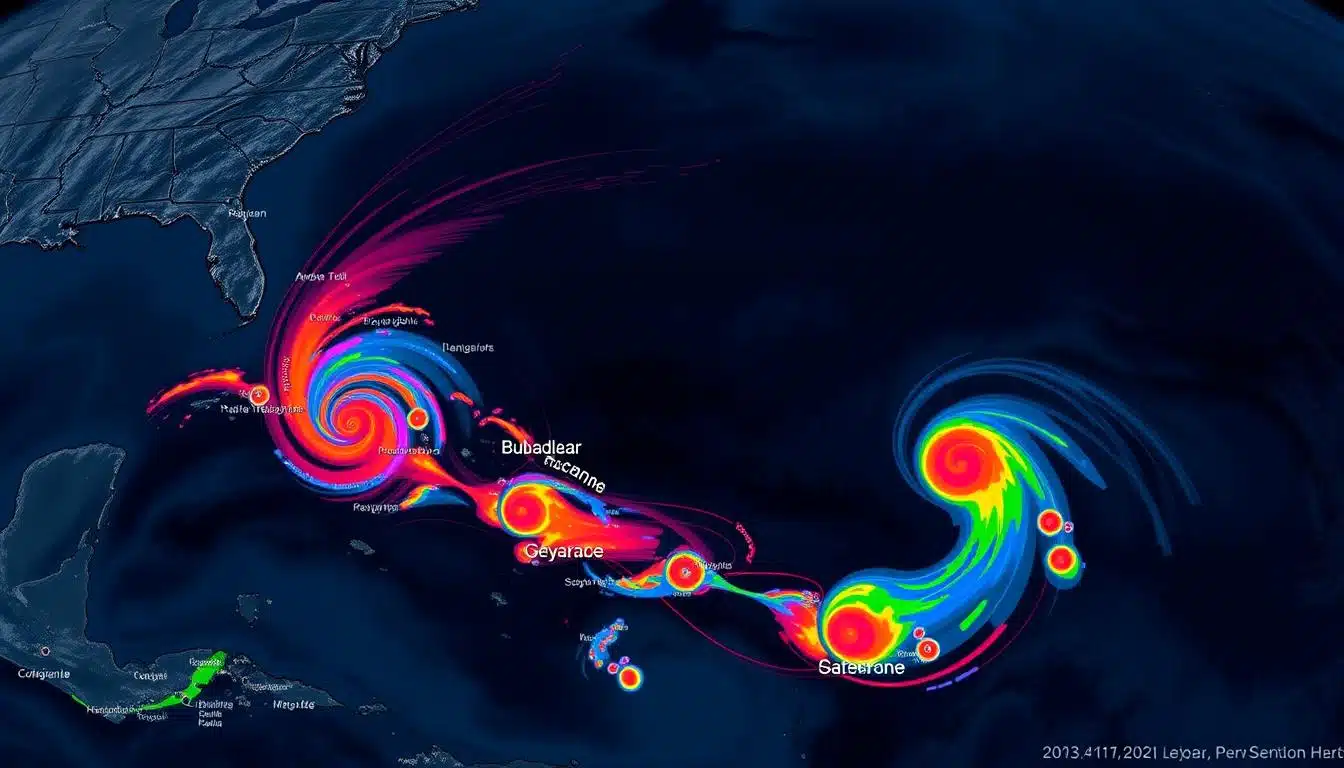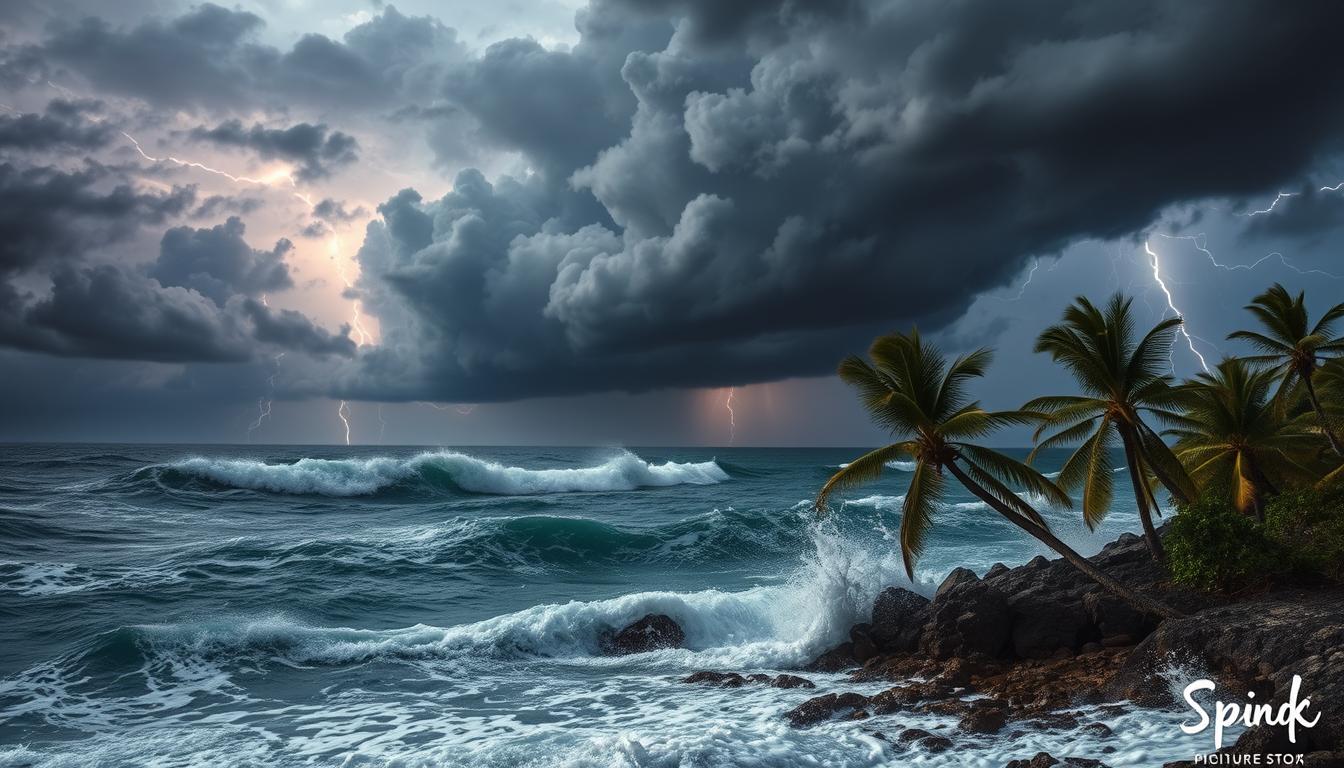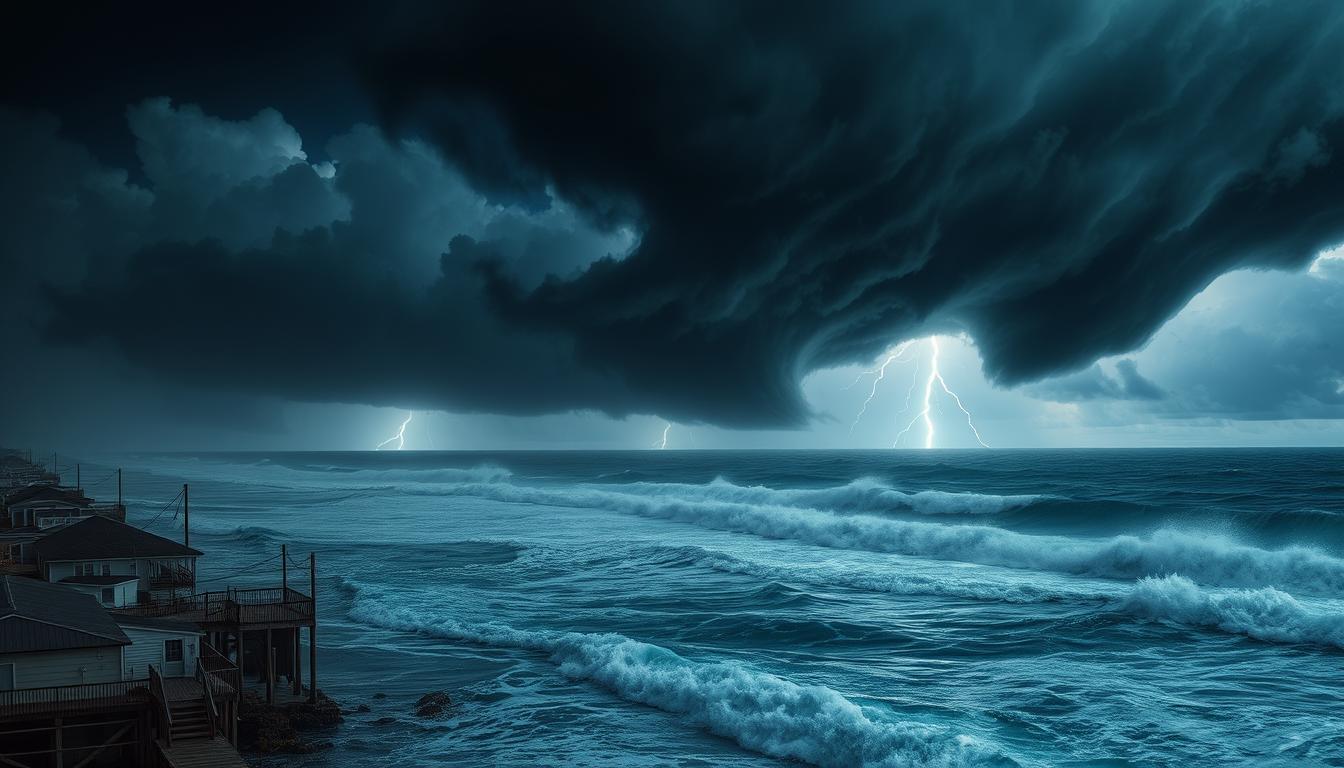Is the 2023 hurricane season catching you off guard? What if you could stay ahead with real-time updates on storm tracks and impacts? Our hurricane tracker gives you the vital info to stay safe and informed.
Hurricane Helene’s intensification has us keeping you in the loop. We’re focused on the storm’s path and how to protect communities. With satellite images, plane data, forecasts, and alerts, we help you make smart choices and dodge nature’s wrath1.
Key Takeaways
- Comprehensive real-time updates on hurricane paths and forecasts
- Detailed information on storm intensity, wind speeds, and potential impacts
- Vital evacuation alerts and emergency preparedness tips
- Advanced forecasting tools to predict storm trajectories with precision
- Reliable sources and trusted weather experts to guide you through the hurricane season
Monitoring Hurricane Helene’s Destructive Path
As Hurricane Helene heads towards the Florida coast, experts are watching it closely. They use satellite images and planes to track its growth. The storm is expected to hit with winds of 130 mph on Thursday or Friday morning2.
Satellite Imagery and Recon Planes Track Helene’s Intensification
Helene is now a Category 2 hurricane with winds of 100 mph, according to the National Hurricane Center3. It’s about 320 miles southwest of Tampa and 365 miles south of Apalachicola. It’s moving north-northeast at 12 mph3.
Experts say Helene will get stronger, possibly becoming a major hurricane. It could have winds of 115 mph and gusts up to 140 mph3. This would make it one of the biggest storms to hit the Southeast U.S. in years2.
Helene Poses “Nightmare Surge Scenario” for Florida’s Big Bend
The National Weather Service warns of a “nightmare surge scenario” for the Florida Big Bend. This area could face catastrophic flooding and storm surge2. Coastal areas might see 15 to 20 feet of storm surge above ground level3.
South Florida has already seen wind gusts up to 55 mph. Sustained winds are expected to stay below 40 mph2.
Florida residents are preparing by getting sandbags and boarding up windows. Schools and universities are closed due to the threat2. Evacuation orders have been issued for 16 counties, and there’s a risk of tornadoes in western Florida and southern Alabama3.
With Helene getting stronger and the risk of storm surge, experts are on high alert. They urge residents to follow evacuation orders and prepare for the worst. The next few days will be crucial as this powerful hurricane approaches the Florida coast.
Widespread Warnings Issued Across Florida
As Hurricane Helene gets closer to Florida, people all over the state are getting ready2. The storm’s strong winds are expected to hit just west of the Florida Keys2. Forecasters say it will bring winds of 130 mph, posing a big threat2.
Only three Gulf hurricanes since 1988 have been as big as Helene: 2017’s Irma, 2005’s Wilma, and 1995’s Opal2.
Hurricane Warnings Span from Tampa Bay to Mexico Beach
A hurricane warning covers the west coast of Florida, from Tampa Bay to Mexico Beach2. This warning includes almost the whole Florida peninsula2. Forecasters warn of a “nightmare surge scenario” for Apalachee Bay, urging people to take evacuation orders seriously2.
Tropical storm-force winds have already hit the Florida Keys and are moving towards South Florida2.
The entire Florida coast is under hurricane and tropical storm warnings, including Palm Beach, Broward, and Miami-Dade counties2. Schools and universities are closed, and government offices and buildings are shut down in preparation2.
The hurricane center warns of long power outages, fallen trees, and dangerous flooding in the Southeast2. The Panhandle could see 15 to 20 feet of storm surge2. The hurricane is 320 miles southwest of Tampa, moving north-northeast at 12 mph with winds of 100 mph2.
The storm’s effects will be felt far inland, with wind gusts up to 55 mph in South Florida2. West Palm Beach to Miami has a 10 to 15% chance of tropical-storm-force winds2. A catastrophic storm surge of up to 20 feet is forecasted for parts of the Florida Big Bend coast2.
University of Georgia meteorology professor Marshall Shepherd says Helene could be the worst storm in 35 years for Atlanta2. People across the state are urged to finish their storm preparations, with some stations in Tallahassee already out of gas2.
Potential for Catastrophic Storm Surge and Flooding
Hurricane Helene is getting stronger, and the National Hurricane Center warns of a deadly storm surge along the Florida Big Bend coast2. The storm could hit with winds up to 130 mph, posing a huge threat to coastal areas2.
The storm surge threat is high, with possible flooding of up to 20 feet above ground2. Places like Alligator Point and Panacea are getting ready for the storm. Authorities predict power outages, fallen trees, and dangerous flooding2. Only three Gulf hurricanes since 1988 have had a bigger wind field than Helene2.
| Storm Surge Threat | Wind Impacts | Regional Preparations |
|---|---|---|
Flooding is a big worry, not just for coastal areas but also inland4. As Helene moves into Georgia and the Carolinas, power outages will affect a large area4.
Governor Ron DeSantis and the Director of the Florida Division of Emergency Management stress the need for emergency plans2. With Helene’s wind field and storm surge forecasts, it’s crucial to take action to protect lives and property4.
Hurricane Helene is getting stronger and is heading towards the Florida coast3. The threat of storm surge and flooding is serious, with possible 20 feet of flooding and power outages243. Everyone needs to stay alert and ready for the challenges ahead243.
Hurricane Tracker 2023: Vital Updates on Helene’s Wind Field
The 2023 hurricane season is in full swing, and our tracker is keeping you updated on Tropical Storm Helene. This storm is expected to be one of the largest, with hurricane-force winds extending outward up to 50 miles from the center5. This could cause power outages, fallen trees, and dangerous conditions in a wide area, including inland.
Helene’s large wind field is a key factor to watch as it moves towards the Southeast. The storm is expected to have one of the largest wind fields of any hurricane to hit the region in years5. This poses a big threat to both coastal and inland areas. Emergency teams are warning people to take this seriously and get ready.
- Helene’s expansive wind field could lead to widespread power outages across a large area
- Toppled trees and debris pose a danger to homes, businesses, and infrastructure
- Inland areas may experience tropical storm-force winds and significant impacts
As we watch Helene, it’s important for those in its path to listen to warnings and follow evacuation orders. Our hurricane tracker will provide updates to help you stay informed and ready for this storm.
“Helene’s wind field is larger than any hurricane we’ve seen in this region in years. The potential for widespread power outages and damage is very real, and residents need to take this threat seriously.”
– Local Emergency Management Director
Evacuations and School Closures Underway
As Hurricane Helene gets closer to Florida, emergency teams have called for evacuations and school closures. Helene has grown into a Category 2 hurricane with 100 mph winds. It could get even stronger before hitting land.
Many schools and universities are closed to keep students and staff safe. Florida’s coast is under tropical storm warnings and hurricane watches. Storm surge could be 1-3 feet in some places, up to 20 feet in others6.
Residents Urged to Heed Evacuation Orders Immediately
People in the storm’s path need to leave now and get ready for safety. The hurricane will bring heavy rain and strong winds. Rain could be 6-12 inches, with gusts over 80 mph36.
Those affected should prepare their homes and follow evacuation orders. Keeping everyone safe is the main goal as Florida prepares for Hurricane Helene.
“Residents in the storm’s path have been urged to heed evacuation orders immediately and complete their preparations to ensure their safety.”
Tracking Helene’s Inland Impacts Across the Southeast
Hurricane Helene is heading straight for the Florida coast. Its effects will reach far beyond the coast. The storm could be the worst to hit a major Southern city in 35 years2.
Helene is expected to bring winds up to 130 mph. This makes it one of the largest hurricanes in the region24. Its huge size means many areas will face its full force, even if they’re not near the coast2.
The Southeast is bracing for long power outages, fallen trees, and flooding. The storm is 320 miles southwest of Tampa, moving north-northeast at 12 mph2.
61 out of Florida’s 67 counties have declared emergencies4. Officials are telling people to leave now. The danger of storm surge and flooding is real4.
| Metric | Value |
|---|---|
| Maximum Sustained Wind Speed | 90 mph7 |
| Minimum Central Pressure | 966 mb7 |
| Projected Landfall Location | Florida Big Bend area7 |
| Forecasted Storm Surge Heights | 15-20 feet in Carrabelle to Suwannee River area7 |
| Extent of Tropical Storm Force Winds | 345 miles from the center7 |
| Hurricane Wind Radius | 60 miles7 |
| Expected Rainfall | 6-12 inches, with possibility of locally higher amounts7 |
| Potential Tornado Threat Locations | Florida, southeast Georgia, and the Carolinas7 |
As Helene moves inland, the danger will spread to Georgia, the Carolinas, Tennessee, and Kentucky4. Keeping up with local updates and evacuation notices is key for those affected4.
“Helene is a nightmare scenario for the Florida Big Bend region, with the potential for catastrophic storm surge and flooding that could reach 20 feet or more above ground level. This is an extremely dangerous situation, and we urge all residents in the path of the storm to heed evacuation orders immediately.”
– NWS Meteorologist
Emergency Preparedness Tips for Hurricane Season
As we face the 2023 hurricane season, being ready and informed is key. Our hurricane tracker gives you the latest on storm paths, wind speeds, and safety alerts. This helps you make smart choices8. Also, people in areas prone to hurricanes should check their emergency plans, stock up on supplies, and follow evacuation orders8.
Stay Informed with Reliable Hurricane Tracker 2023 Sources
Having the right info is crucial to stay ahead of the storm. Our tracker offers a detailed view of the latest news, including forecasts and warnings8. By keeping up, you can protect yourself and your family9.
Preparation is everything. Check your emergency kit, make sure you have enough food, water, and supplies. Be ready to leave if told to do so9. Our tracker will keep you updated to ensure your safety this hurricane season.
“Preparedness is the key to weathering any storm, and with the right information and resources, we can all stay safe during this hurricane season.”
| Emergency Supplies | Evacuation Checklist |
|---|---|
|
|
By using our reliable hurricane tracker 2023 and following these tips, you can better face the storm. This way, you can keep your family safe89.
Advanced Forecasting Tools Aid Storm Path Predictions
Our hurricane tracker uses advanced tools to predict Hurricane Helene’s path and strength. We use satellite images, data from reconnaissance planes, and weather models. This helps us give people timely and accurate info to prepare for the storm2.
These tools are key for emergency planning and keeping people safe. Hurricane Helene is expected to grow stronger, with winds up to 130 mph. This makes it one of the biggest storms in years2. The Florida coast could see up to 20 feet of storm surge, and the Panhandle might get 15 to 20 feet2.
As Helene moves towards the Southeast, we’re dedicated to keeping our readers informed. We use the latest in hurricane forecasting to track the storm. This helps us predict its effects and support emergency plans in the area210.
















Leave a Reply